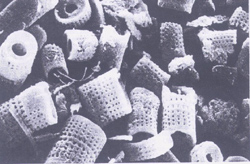
DIATOMACEOUS EARTHS |
| Diatomaceous earths (DE) are formed from the fossils of microscopic planktons called diatoms, which are found in fresh and salt water. When diatoms die, they sink to the bottom of oceans or freshwater
lakes and accumulate into a sedimentary layer, which over the centuries
builds up and becomes compressed and fossilised into a soft chalky
rock called diatomaceous earth.
However, insect species differ in their sensitivity to the various DEs and laboratory trials at NRI have found that LGB (Prostephanus truncatus) is less susceptible to DEs than some of the other storage insect pests such as Sitophilus spp. In the field trials in Zimbabwe another Bostrichid beetle Rhyzopertha dominica was also found to be less susceptible to DEs than other storage pests. As a result a range of application rates of DEs and a mixture of DE with the pyrethroid permethrin have been included along with traditional farmer grain protection practices such as grain admixture with ash, in the Tanzanian field trials to determine how DEs can best be used to reduce damage caused by LGB and other bostrichid beetles. The use of diatomaceous earths in pest control is not new. Observations of birds and mammals taking dust baths to rid themselves of mites and parasites is believed to have led the Chinese to start using diatomaceous earths in pest control more than 4000 years ago. DEs have extremely low toxicity to mammals (e.g. DE rat oral LD50, >5000 mg/kg), and are considered 'Generally Regarded As Safe' by the USA Environmental Protection Authority. The US Food and Drug Agency has exempted DE from requirements of fixed residue levels when added to stored grain. The only possible negative health effect comes from long-term chronic exposure to quantities of inhaled dust, and safety precautions such as the wearing of masks need to be taken by workers during DE application. Many DE dusts are now commercially available, and are registered for use as grain protectants in Australia, Brazil, Canada, Croatia, China, Germany, Indonesia, Japan, Philippines, Saudi Arabia, United Arab Emirates and USA. DEs can be used for managing stored product insects and mites, improving fumigation and aeration efficiency, and structural treatments. DEs are approved for organic processing. The Small scale farmer utilisation of diatomaceous earths during
storage project has six main outputs
that it plans to achieve. |
Updated:
21/3/03 |
| Copyright ©
2003 University of Greenwich |
 DE
looks similar to talcum powder, however if you were to put your
finger into the DE you would find it makes your fingers feel quite
dry. DEs exert their effect on insects through physical means. When
insects come into contact with the DE particles, waxes are absorbed
from the cuticle (or outside skin) of the insect, as a result the
insect loses its waterproofing and dehydrates and dies.
DE
looks similar to talcum powder, however if you were to put your
finger into the DE you would find it makes your fingers feel quite
dry. DEs exert their effect on insects through physical means. When
insects come into contact with the DE particles, waxes are absorbed
from the cuticle (or outside skin) of the insect, as a result the
insect loses its waterproofing and dehydrates and dies.